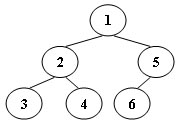An inorder binary tree traversal can be implemented in a non-recursive way with a stack. For example, suppose that when a 6-node binary tree (with the keys numbered from 1 to 6) is traversed, the stack operations are: push(1); push(2); push(3); pop(); pop(); push(4); pop(); pop(); push(5); push(6); pop(); pop(). Then a unique binary tree (shown in Figure 1) can be generated from this sequence of operations. Your task is to give the postorder traversal sequence of this tree.

Each input file contains one test case. For each case, the first line contains a positive integer N (≤30) which is the total number of nodes in a tree (and hence the nodes are numbered from 1 to N). Then 2N lines follow, each describes a stack operation in the format: "Push X" where X is the index of the node being pushed onto the stack; or "Pop" meaning to pop one node from the stack.
For each test case, print the postorder traversal sequence of the corresponding tree in one line. A solution is guaranteed to exist. All the numbers must be separated by exactly one space, and there must be no extra space at the end of the line.
6
Push 1
Push 2
Push 3
Pop
Pop
Push 4
Pop
Pop
Push 5
Push 6
Pop
Pop3 4 2 6 5 1
给定先序遍历和中序遍历生成二叉树 输出后续遍历的结果
#include <iostream> #include <vector> #include <map> using namespace std; class tnode{ public: int data; tnode* left{nullptr}; tnode* right{nullptr}; tnode()=default; tnode(int d):data{d}{ } }; class tree{ public: tnode* root; int height; tree(){ tnode* node=new tnode; root=node; } }; void generateTree(tree &t){ //根据给定的先序和中序遍历 //建树 int n,temp; vector<tnode*> stack; string str; cin >>n; cin >> str >> temp; tnode* curNode=t.root; curNode->data=temp; curNode->left=nullptr; curNode->right=nullptr; stack.push_back(curNode); for(int i=0;i<2*n;i++){ cin >> str; if(str=="Pop"){// curNode=stack.back(); stack.pop_back(); }else{ cin >> temp; tnode* newNode=new tnode{temp}; if(!curNode->left){ curNode->left=newNode; curNode=curNode->left; }else if(!curNode->right){ curNode->right=newNode; curNode=curNode->right; } stack.push_back(newNode); } } } void postOrderTraversal(tnode* p,int rootData){ if(p){ if(p->left){ postOrderTraversal(p->left,rootData); } if(p->right){ postOrderTraversal(p->right,rootData); } cout << p->data; if(rootData!=p->data){ cout<<" "; } } } int main(){ tree t; generateTree(t); postOrderTraversal(t.root,t.root->data); return 0; }
数据结构 03-树3 Tree Traversals Again (25 分)
原文:https://www.cnblogs.com/ichiha/p/14779228.html